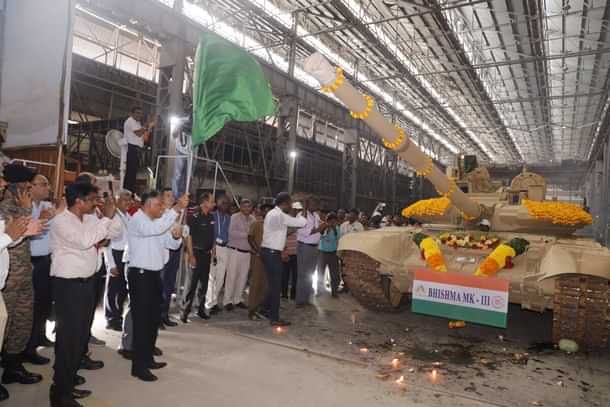Defence
Explained: All About The Upgrades The Newly Unveiled T-90 Bhishma Mk-III Tank Is Likely To Sport
Ujjwal Shrotryia
May 15, 2024, 10:40 AM | Updated 12:18 PM IST
Save & read from anywhere!
Bookmark stories for easy access on any device or the Swarajya app.


Heavy Vehicle Factory (HVF) Avadi rolled out the first batch of 10 advanced T-90 Bhishma Mk-III tanks on Monday (13 May) from the earlier order of 464 tanks.
The Indian Army currently operates more than 1,200 T-90 Bhishma tanks imported from Russia. These tanks have been the mainstay of the Indian armoured fleet alongside the more than 2,400 vintage T-72 tanks and 124 Arjun Mk-1 tanks.
India is manufacturing these tanks under licence from Russia.
These new tanks are from the order of an additional 464 T-90 tanks reported in 2019. However, it is the first time that any government entity has used the designation T-90 Mk-III.

The changed designation hints that the new tanks carry some upgrades over the earlier T-90S Bhishma variant.
Last year in November, the Defence Acquisition Council (DAC) approved the acceptance of necessity (AoN) for the procurement and integration of the Automatic Target Tracker (ATT) and Digital Ballistic Computer (DBC) on T-90 tanks.
The ATT allows the T-90 to keep track of a moving target more precisely. Before this integration, gunners had to manually predict where the target would be and then fire the round.
This process increases the chances of a miss, especially when the tank and the target both are moving. The accuracy of tank is also highly dependent on the training of the gunnery crew. The ATT allows the gunner to simply point the tank gun in the direction of the target, and the system automatically tracks the target.
Meanwhile, the DBC allows the tank to automatically calculate where the round will land, relieving the workload of the gunner who can now focus on finding other targets on the battlefield.
Both the ATT and DBC, in short, greatly increases the accuracy of the tank.
Last year in July 2023, the Indian Army ordered 400 software-defined radios (SDRs) from Alpha Design Technologies (acquired by Adani Defence) for installation on T-90 tanks. The SDRs will allow networking between the tanks, sharing data in a secure fashion, and increasing the tank commanders' situational awareness.
A year before that (in February 2022), the army ordered new Bharat Electronics Limited (BEL) built thermal imaging commanders' sights.
These new sights will allow the tanks to detect targets out to a distance of eight kilometres in both day and night, while the laser range finder can find ranges accurately over five kilometres. Both these modifications will make the tank more lethal in detecting enemy targets.
It is likely that the T-90 Mk-III tanks revealed day before yesterday have all these electronic upgrades installed apart from other such electronic modifications.
From the pictures released by an X post by the HVF Avadi Twitter handle, no physical upgrades can be identified.
This, however, points out a glaring flaw in the Indian Army’s procurement policy. All of the upgrades mentioned above were available with the Arjun tanks. In fact, the commanders' sights, the ATT, and the DBC are all taken from Arjun (and modified for the T-90).
Even then, the army chose to go with the T-90 tank while giving step-motherly treatment to Arjun.
Despite all these limitations, the army went ahead and still bought 464 more T-90 tanks in 2019, while an even more advanced variant of Arjun, the Arjun Mk-1A, was available from 2018.
It is reported that the army denied ordering Arjun Mk-1A citing various flimsy reasons like high import content, spare parts scarcity, and the lack of suitable ammunition.
The army, it seems, has not learned from its mistakes even now. The Qualitative Requirements (QRs) of the Indian Army for the next-generation Future Ready Combat Vehicle look to be a repeat of the same Arjun fiasco.
Also Read: After Killing Arjun, Army Sets Up Next-Generation Tank Project For Failure
Staff Writer at Swarajya. Writes on Indian Military and Defence.





